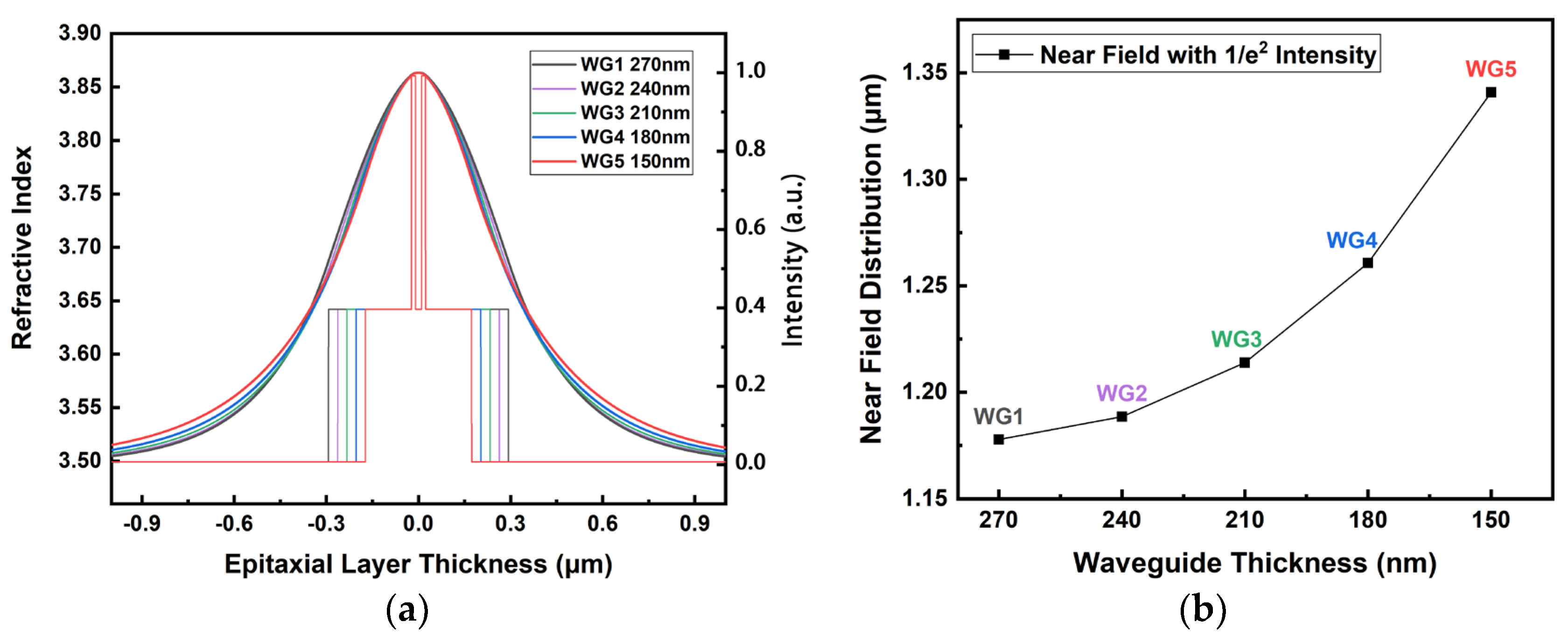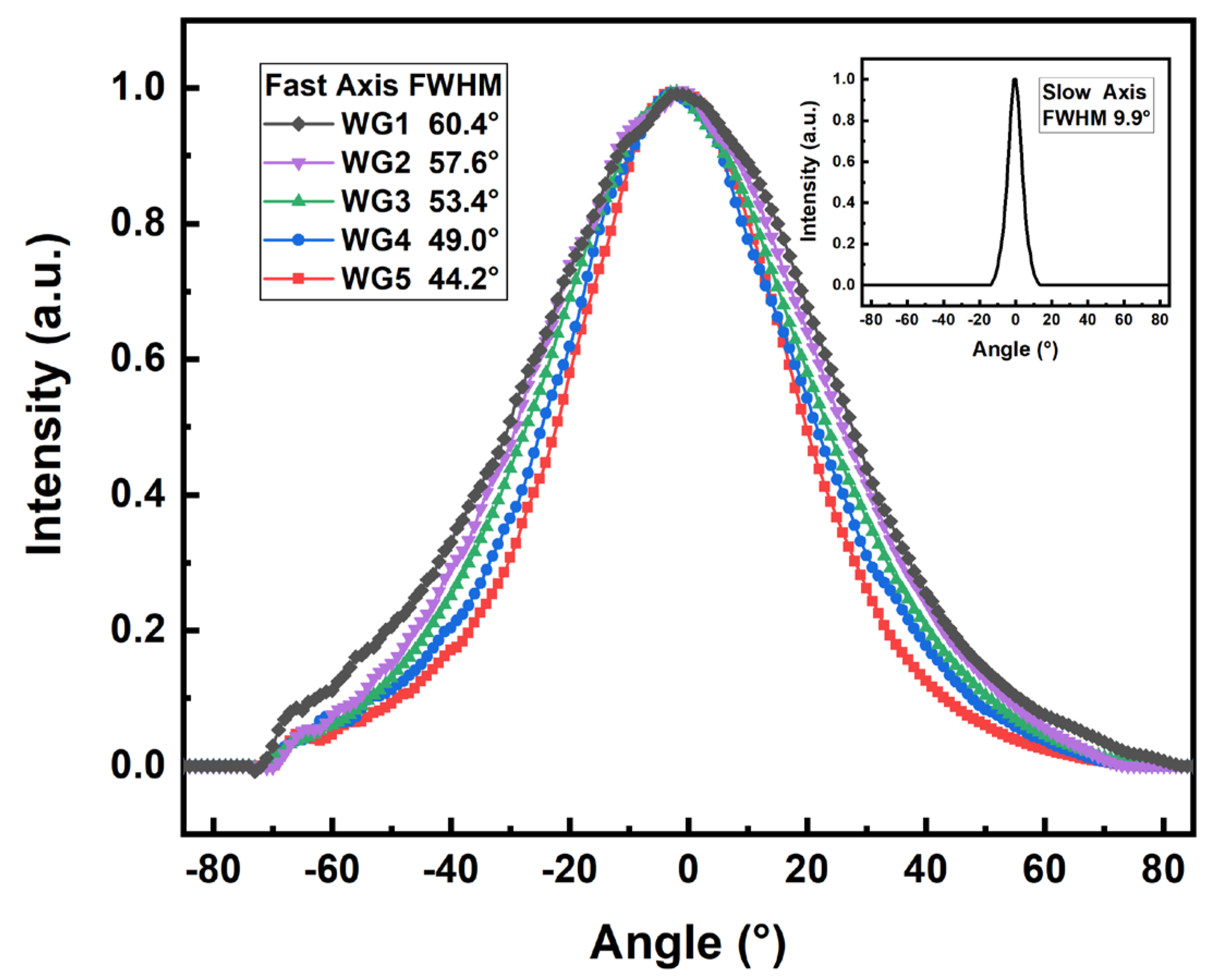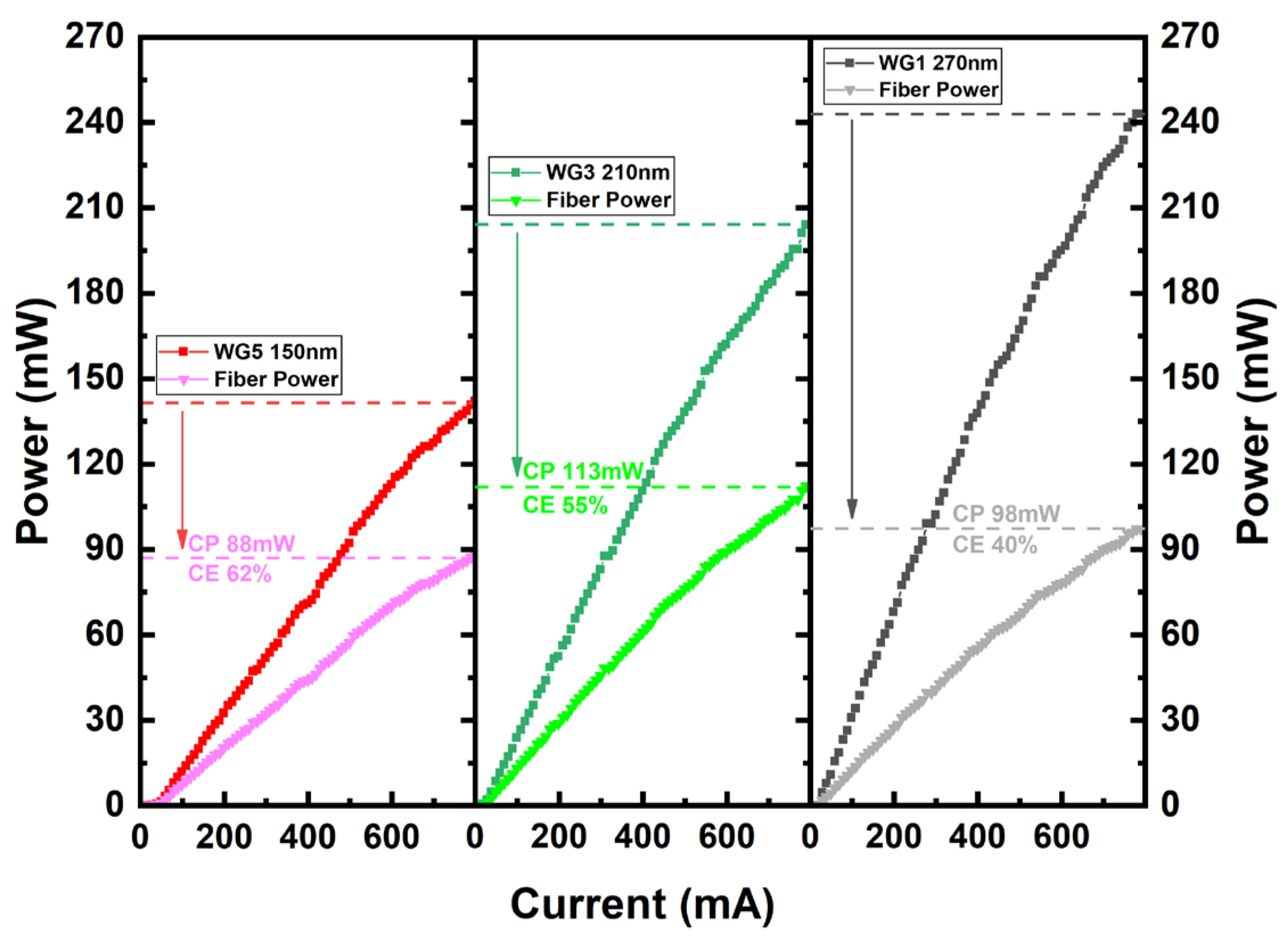Coupling Performance Enhancement of GaSb-Based Single-Transverse-Mode Lasers with Reduced Beam Divergence Obtained via near Field Modulation
Abstract
1. Introduction
2. Materials and Methods
3. Results
4. Discussions
5. Conclusions
Author Contributions
Funding
Institutional Review Board Statement
Informed Consent Statement
Data Availability Statement
Conflicts of Interest
References
- Rattunde, M.; Schmitz, J.; Kaufel, G.; Kelemen, M.; Weber, J.; Wagner, J. GaSb-based 2.0× μm quantum-well diode lasers with low beam divergence and high output power. Appl. Phys. Lett. 2006, 88, 3. [Google Scholar] [CrossRef]
- Chen, J.F.; Kipshidze, G.; Shterengas, L. Diode lasers with asymmetric waveguide and improved beam properties. Appl. Phys. Lett. 2010, 96, 3. [Google Scholar] [CrossRef]
- Geerlings, E.; Rattunde, M.; Schmitz, J.; Kaufel, G.; Zappe, H.; Wagner, J. Widely tunable GaSb-based external cavity diode laser emitting around 2.3 μm. IEEE Photonics Technol. Lett. 2006, 18, 1913–1915. [Google Scholar] [CrossRef]
- Wang, R.J.; Malik, A.; Simonyte, I.; Vizbaras, A.; Vizbaras, K.; Roelkens, G. Compact GaSb/silicon-on-insulator 2.0x μm widely tunable external cavity lasers. Opt. Express 2016, 24, 28978–28987. [Google Scholar] [CrossRef] [PubMed]
- Hoppe, M.; Assmann, C.; Schmidtmann, S.; Milde, T.; Honsberg, M.; Schanze, T.; Sacher, J. GaSb-based digital distributed feedback filter laser diodes for gas sensing applications in the mid-infrared region. J. Opt. Soc. Am. B-Opt. Phys. 2021, 38, B1–B8. [Google Scholar] [CrossRef]
- Jean, B.; Bende, T. Mid-IR laser applications in medicine. In Solid-State Mid-Infrared Laser Sources; Sorokina, I.T., Vodopyanov, K.L., Eds.; Topics in Applied Physics; Springer: Berlin/Heidelberg, Germany, 2003; Volume 89, pp. 511–544. [Google Scholar]
- Liu, J.; Shi, H.X.; Liu, K.; Hou, Y.B.; Wang, P. 210 W single-frequency, single-polarization, thulium-doped all-fiber MOPA. Opt. Express 2014, 22, 13572–13578. [Google Scholar] [CrossRef] [PubMed]
- Garbuzov, D.Z.; Martinelli, R.U.; Lee, H.; York, P.K.; Menna, R.J.; Connolly, J.C.; Narayan, S.Y. Ultralow-loss broadened-waveguide high-power 2 μm AlGaAsS/InGaAsSb/GaSb separate-confinement quantum-well lasers. Appl. Phys. Lett. 1996, 69, 2006–2008. [Google Scholar] [CrossRef]
- Lin, C.; Grau, M.; Dier, O.; Amann, M.C. Low threshold room-temperature continuous-wave operation of 2.24–3.04 μm GaInAsSb/AlGaAsSb quantum-well lasers. Appl. Phys. Lett. 2004, 84, 5088–5090. [Google Scholar] [CrossRef]
- Kelemen, M.T.; Weber, J.; Rattunde, M.; Kaufel, G.; Schmitz, J.; Moritz, R.; Mikulla, M.; Wagner, J. High-power 1.9-μm diode laser arrays with reduced far-field angle. IEEE Photonics Technol. Lett. 2006, 18, 628–630. [Google Scholar] [CrossRef]
- Wang, T.F.; Yang, C.G.; Zhang, Y.; Chen, Y.H.; Shang, J.M.; Zhang, Y.; Xu, Y.Q.; Niu, Z.C. High spectral purity GaSb-based blazed grating external cavity laser with tunable single-mode operation around 1940 nm. Opt. Express 2021, 29, 33864–33873. [Google Scholar] [CrossRef]
- Miah, M.J.; Kalosha, V.P.; Bimberg, D.; Pohl, J.; Weyers, M. Astigmatism-free high-brightness 1060 nm edge-emitting lasers with narrow circular beam profile. Opt. Express 2016, 24, 30514–30522. [Google Scholar] [CrossRef] [PubMed]
- Miah, M.J.; Kettler, T.; Posilovic, K.; Kalosha, V.P.; Skoczowsky, D.; Rosales, R.; Bimberg, D.; Pohl, J.; Weyers, M. 1.9 W continuous-wave single transverse mode emission from 1060 nm edge-emitting lasers with vertically extended lasing area. Appl. Phys. Lett. 2014, 105, 4. [Google Scholar] [CrossRef]
- Zhao, S.Y.; Wang, Y.F.; Qu, H.W.; Liu, Y.; Zhou, X.Y.; Liu, A.J.; Zheng, W.H. 2-W High-Efficiency Ridge-Waveguide Lasers With Single Transverse Mode and Low Vertical Divergence. IEEE Photonics Technol. Lett. 2017, 29, 2005–2007. [Google Scholar] [CrossRef]
- Rattunde, A.; Geerlings, E.; Schmitz, J.; Kaufel, G.; Weber, J.; Mikulla, M.; Wagner, J. GaSb-based 1.9–2.4 μm quantum-well diode lasers with low beam divergence. In Proceedings of the Conference on Novel In-Plane Semiconductor Lasers IV, San Jose, CA, USA, 24–27 January 2005; pp. 138–145. [Google Scholar]
- Ryvkin, B.S.; Avrutin, E.A. Nonbroadened asymmetric waveguide diode lasers promise much narrower far fields than broadened symmetric waveguide ones. J. Appl. Phys. 2005, 98, 2. [Google Scholar] [CrossRef]
- Rattunde, M.; Schmitz, J.; Kiefer, R.; Wagner, J. Comprehensive analysis of the internal losses in 2.0 μm (AlGaIn)(AsSb) quantum-well diode lasers. Appl. Phys. Lett. 2004, 84, 4750–4752. [Google Scholar] [CrossRef]
- Chen, J.F.; Kipshidze, G.; Shterengas, L. High-Power 2 μm Diode Lasers With Asymmetric Waveguide. IEEE J. Quantum Electron. 2010, 46, 1464–1469. [Google Scholar] [CrossRef]
- Xie, S.W.; Zhang, Y.; Yang, C.A.; Huang, S.S.; Yuan, Y.; Zhang, Y.; Shang, J.M.; Shao, F.H.; Xu, Y.Q.; Ni, H.Q.; et al. High performance GaSb based digital-grown InGaSb/AlGaAsSb mid-infrared lasers and bars. Chin. Phys. B 2019, 28, 4. [Google Scholar] [CrossRef]
- Archambault, J.L.; Grubb, S.G. Fiber gratings in lasers and amplifiers. J. Light. Technol. 1997, 15, 1378–1390. [Google Scholar] [CrossRef]
- Guan, X.C.; Yang, C.S.; Gu, Q.; Wang, W.W.; Tan, T.Y.; Zhao, Q.L.; Lin, W.; Wei, X.M.; Yang, Z.M.; Xu, S.H. 55 W kilohertz-linewidth core- and in-band-pumped linearly polarized single-frequency fiber laser at 1950 nm. Opt. Lett. 2020, 45, 2343–2346. [Google Scholar] [CrossRef]
- Wang, X.; Zhou, P.; Wang, X.L.; Xiao, H.; Si, L. 102 W monolithic single frequency Tm-doped fiber MOPA. Opt. Express 2013, 21, 32386–32392. [Google Scholar] [CrossRef]
- Yang, C.A.; Xie, S.W.; Zhang, Y.; Shang, J.M.; Huang, S.S.; Yuan, Y.; Shao, F.H.; Zhang, Y.; Xu, Y.Q.; Niu, Z.C. High-power, high-spectral-purity GaSb-based laterally coupled distributed feedback lasers with metal gratings emitting at 2 μm. Appl. Phys. Lett. 2019, 114, 5. [Google Scholar] [CrossRef]
- Luo, H.; Yang, C.; Xie, S.; Chai, X.; Huang, S.; Zhang, Y.; Xu, Y.; Niu, Z. High order DBR GaSb based single longitude mode diode lasers at 2 μm wavelength. J. Semicond. 2018, 39, 104007. [Google Scholar] [CrossRef]




Publisher’s Note: MDPI stays neutral with regard to jurisdictional claims in published maps and institutional affiliations. |
© 2022 by the authors. Licensee MDPI, Basel, Switzerland. This article is an open access article distributed under the terms and conditions of the Creative Commons Attribution (CC BY) license (https://creativecommons.org/licenses/by/4.0/).
Share and Cite
Wang, T.; Yang, C.; Chen, Y.; Yu, H.; Shi, J.; Su, X.; Zhang, Y.; Xu, Y.; Ni, H.; Niu, Z. Coupling Performance Enhancement of GaSb-Based Single-Transverse-Mode Lasers with Reduced Beam Divergence Obtained via near Field Modulation. Photonics 2022, 9, 942. https://doi.org/10.3390/photonics9120942
Wang T, Yang C, Chen Y, Yu H, Shi J, Su X, Zhang Y, Xu Y, Ni H, Niu Z. Coupling Performance Enhancement of GaSb-Based Single-Transverse-Mode Lasers with Reduced Beam Divergence Obtained via near Field Modulation. Photonics. 2022; 9(12):942. https://doi.org/10.3390/photonics9120942
Chicago/Turabian StyleWang, Tianfang, Chengao Yang, Yihang Chen, Hongguang Yu, Jianmei Shi, Xiangbin Su, Yu Zhang, Yingqiang Xu, Haiqiao Ni, and Zhichuan Niu. 2022. "Coupling Performance Enhancement of GaSb-Based Single-Transverse-Mode Lasers with Reduced Beam Divergence Obtained via near Field Modulation" Photonics 9, no. 12: 942. https://doi.org/10.3390/photonics9120942
APA StyleWang, T., Yang, C., Chen, Y., Yu, H., Shi, J., Su, X., Zhang, Y., Xu, Y., Ni, H., & Niu, Z. (2022). Coupling Performance Enhancement of GaSb-Based Single-Transverse-Mode Lasers with Reduced Beam Divergence Obtained via near Field Modulation. Photonics, 9(12), 942. https://doi.org/10.3390/photonics9120942






